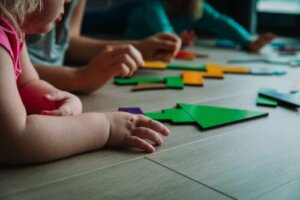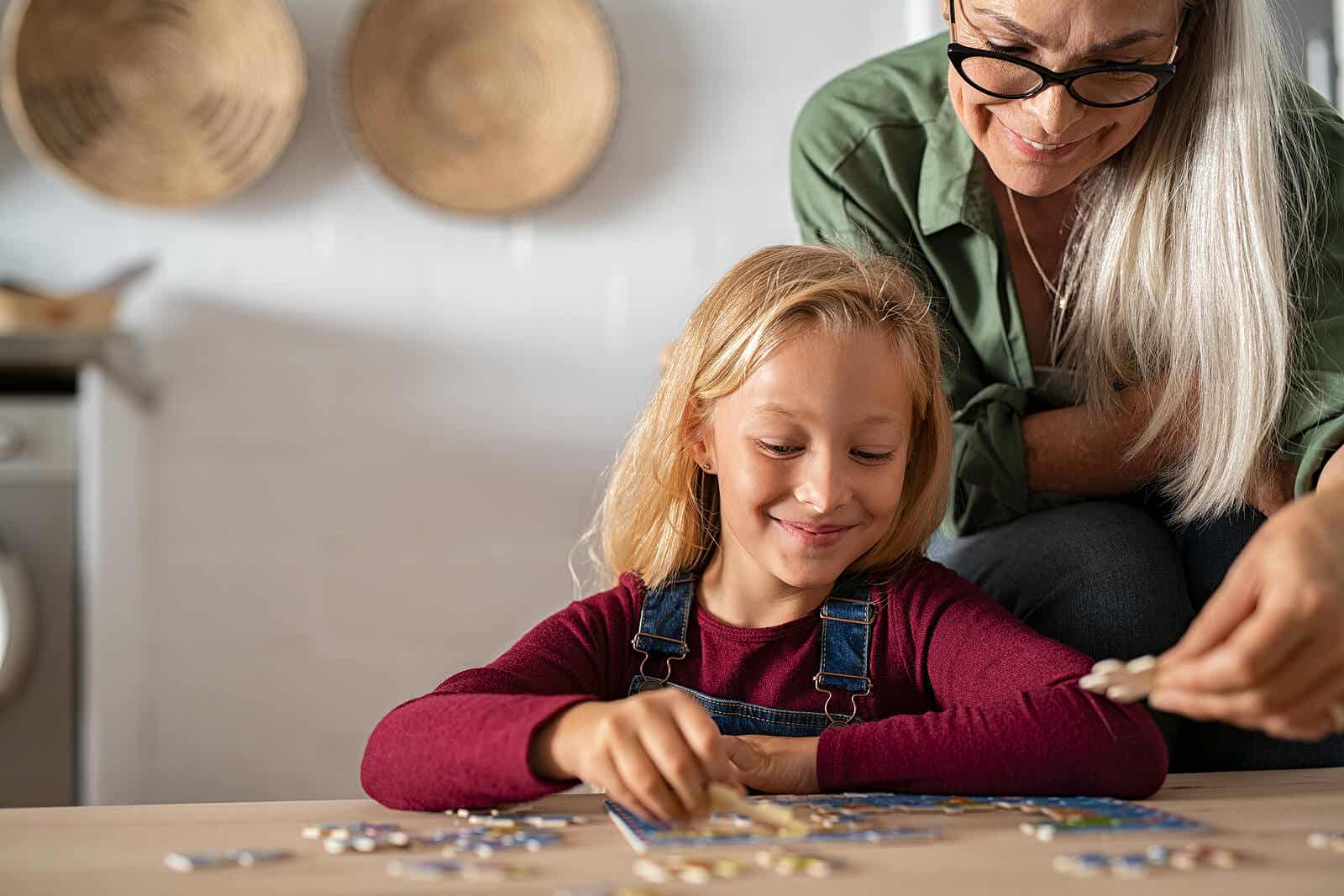5 Activities to Teach Problem-Solving to Young Children

You can teach problem-solving to young children is such a way that it exposes them to opportunities to solve challenges in a safe environment. In this way, children can develop this important life skill. Therefore, using the mind to think of and find solutions is like working a muscle over time. Problem-solving with activities for small children is a great way to achieve this.
Also, the more the mind’s used to solve problems, the stronger the “muscle” will get. So, it’ll become easier and easier to use creativity to solve conflicts or problems that may arise in life without warning. In this sense, problem-solving can be learned in two ways: Through free play or through guided opportunities.
Strategies for problem-solving
First, before beginning activities to teach problem-solving to young children, you need to consider the steps that acquiring problem-solving skills requires:
- Identify the problem
- Define the problem
- Examine the options
- Act on the plan
- See the consequences
- Adapt the action as needed

Therefore, activities at the preschool level don’t need to involve complicated, high-level problems. A simple activity, such as identifying differences in a picture, can work on the first skill needed (identifying a problem).
In addition, playing with construction toys can develop a child’s ability to try various solutions and examine options when, for example, trying to find the best way to build something.
Seeing what happens will be what helps predict consequences. The most basic activities can work on all of these skills and make children proficient at finding solutions.
How do you teach problem-solving with questions?
Next, the language you use around your child and your questioning technique will also greatly affect their understanding of a problem or challenge as simply something they expect to find a solution to.
So, while your child’s playing, or when they encounter a problem, ask questions that guide them to find a potential answer independently. Here are some examples you can use:
- What do you think made the block tower fall?
- If we build it again, how can we change the structure so it won’t fall down next time?
- Is there a better way to do it? If you think of a different way, can we try it and see which one works better?
- Has that worked? The tower fell again, so let’s try another solution.
Resist the temptation to solve all of your child’s problems, including conflicts with friends or siblings. These are important opportunities for children to learn to work things out by negotiating, thinking, and reasoning.
Over time, your child will become accustomed to seeing a problem, understanding it, weighing the options, taking action, and evaluating the consequences. Challenges and difficulties will be seen as challenges to be faced logically and not as “problems”.
5 problem-solving activities
Here are 5 simple and easy games and activities that you can do with your child at home. Many of them are the kind of activities your little one should have daily exposure to in order to improve their skills.
Doing puzzles
In this case, puzzles are one of the best thinking activities out there. Each puzzle is basically a large set of jumbled pieces that will be solved and reassembled. Children need to have regular exposure to puzzles, as they’re great for developing thinking skills.

Memory games
Memory games will develop your child’s memory and attention to detail. Use matching pairs of pictures and place them all face down, shuffled, on a table. Then take turns picking two cards and placing them face-up on the table.
If you have a matching pair, keep them, and, if the pair doesn’t match, turn the cards over until it’s your turn to try again. Encourage your child to concentrate and pay attention to where the pictures are and try to find a matching pair each turn.
Questions at storytime
Get in the habit of asking questions during daily story time that develop higher-order thinking skills. Instead of just reading and having your child passively listening, ask questions throughout so they can focus on problem-solving.
Board Games
Board games are an excellent way to develop problem-solving skills. You can teach the ability to follow rules and move in a logical sequence. Next, introduce games that require a little planning and deeper thinking, such as Monopoly Junior.
Tic-tac-toe
Finally, draw a simple board on a piece of paper or a chalkboard. Take turns adding an “o” or an “x” to the table and see who can make a row of three first.
Your child will probably figure it out in no time and begin to think carefully before taking their turn. This game can also be played with colored tokens or different objects.
We hope these problem-solving activities will help your children improve their skills. So, what are you waiting for to put them into practice while having fun and educational moments together?
You can teach problem-solving to young children is such a way that it exposes them to opportunities to solve challenges in a safe environment. In this way, children can develop this important life skill. Therefore, using the mind to think of and find solutions is like working a muscle over time. Problem-solving with activities for small children is a great way to achieve this.
Also, the more the mind’s used to solve problems, the stronger the “muscle” will get. So, it’ll become easier and easier to use creativity to solve conflicts or problems that may arise in life without warning. In this sense, problem-solving can be learned in two ways: Through free play or through guided opportunities.
Strategies for problem-solving
First, before beginning activities to teach problem-solving to young children, you need to consider the steps that acquiring problem-solving skills requires:
- Identify the problem
- Define the problem
- Examine the options
- Act on the plan
- See the consequences
- Adapt the action as needed

Therefore, activities at the preschool level don’t need to involve complicated, high-level problems. A simple activity, such as identifying differences in a picture, can work on the first skill needed (identifying a problem).
In addition, playing with construction toys can develop a child’s ability to try various solutions and examine options when, for example, trying to find the best way to build something.
Seeing what happens will be what helps predict consequences. The most basic activities can work on all of these skills and make children proficient at finding solutions.
How do you teach problem-solving with questions?
Next, the language you use around your child and your questioning technique will also greatly affect their understanding of a problem or challenge as simply something they expect to find a solution to.
So, while your child’s playing, or when they encounter a problem, ask questions that guide them to find a potential answer independently. Here are some examples you can use:
- What do you think made the block tower fall?
- If we build it again, how can we change the structure so it won’t fall down next time?
- Is there a better way to do it? If you think of a different way, can we try it and see which one works better?
- Has that worked? The tower fell again, so let’s try another solution.
Resist the temptation to solve all of your child’s problems, including conflicts with friends or siblings. These are important opportunities for children to learn to work things out by negotiating, thinking, and reasoning.
Over time, your child will become accustomed to seeing a problem, understanding it, weighing the options, taking action, and evaluating the consequences. Challenges and difficulties will be seen as challenges to be faced logically and not as “problems”.
5 problem-solving activities
Here are 5 simple and easy games and activities that you can do with your child at home. Many of them are the kind of activities your little one should have daily exposure to in order to improve their skills.
Doing puzzles
In this case, puzzles are one of the best thinking activities out there. Each puzzle is basically a large set of jumbled pieces that will be solved and reassembled. Children need to have regular exposure to puzzles, as they’re great for developing thinking skills.

Memory games
Memory games will develop your child’s memory and attention to detail. Use matching pairs of pictures and place them all face down, shuffled, on a table. Then take turns picking two cards and placing them face-up on the table.
If you have a matching pair, keep them, and, if the pair doesn’t match, turn the cards over until it’s your turn to try again. Encourage your child to concentrate and pay attention to where the pictures are and try to find a matching pair each turn.
Questions at storytime
Get in the habit of asking questions during daily story time that develop higher-order thinking skills. Instead of just reading and having your child passively listening, ask questions throughout so they can focus on problem-solving.
Board Games
Board games are an excellent way to develop problem-solving skills. You can teach the ability to follow rules and move in a logical sequence. Next, introduce games that require a little planning and deeper thinking, such as Monopoly Junior.
Tic-tac-toe
Finally, draw a simple board on a piece of paper or a chalkboard. Take turns adding an “o” or an “x” to the table and see who can make a row of three first.
Your child will probably figure it out in no time and begin to think carefully before taking their turn. This game can also be played with colored tokens or different objects.
We hope these problem-solving activities will help your children improve their skills. So, what are you waiting for to put them into practice while having fun and educational moments together?
All cited sources were thoroughly reviewed by our team to ensure their quality, reliability, currency, and validity. The bibliography of this article was considered reliable and of academic or scientific accuracy.
- Cluver, A., Heyman, G. & Carver, L. J. (2013). Young children selectively seek help when solving problems. Journal of experimental child psychology, 115(3), 570–578. Disponible en: https://www.ncbi.nlm.nih.gov/pmc/articles/PMC3661754/
- Kayange, G. M. & Kayange, G. M. (2018). Riddles, Meaning and Rationality/Logic. In G. Muchineripi (Ed.). Meaning and Truth in African Philosophy: Doing African Philosophy with Language, (pp. 73-88). Disponible en: https://link.springer.com/chapter/10.1007/978-3-030-01962-4_5
- Keen R. (2011). The development of problem solving in young children: a critical cognitive skill. Annual review of psychology, 62, 1–21. Disponible en: https://pubmed.ncbi.nlm.nih.gov/20822435/
- Pochinki, N., Reis, D., Casasola, M., et al. (2021). Variabilidad natural en el juego de rompecabezas entre padres e hijos en el hogar. Fronteras en psicología , 12 , 1-12. Disponible en: https://www.ncbi.nlm.nih.gov/pmc/articles/PMC8483633/
This text is provided for informational purposes only and does not replace consultation with a professional. If in doubt, consult your specialist.








